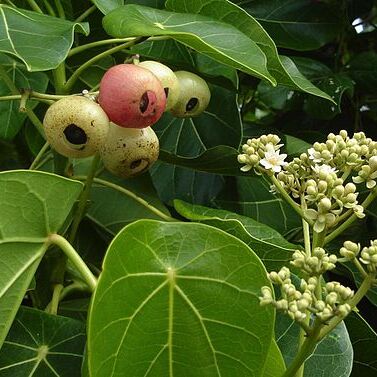Trees, rarely shrubs, in general evergreen (rarely deciduous). Leaves simple (rarely 3-5-lobed), often peltate, cystoliths absent. Inflorescences consisting of a branched axis and flowers in cincinni; peduncles elongate (rarely short); cincinni with 3 flowers (rarely 2 or 1): 2 (1) lateral male flower(s) and 1 central, subsessile female flower (rarely bisexual) on branches of the first (rarely second) order, or on main axis; upper parts of branches somewhat tawny or white pubescent, rarely glabrous; bracts generally present; bracteoles of male flowers 4, ± equal, free, partly including flower buds from cincinnus, bracteoles of female flower 2, connate, forming fleshy, campanulate cupule. Flower buds ovoid, rarely globose. Flowers bisexual or unisexual, then monoecious, rarely dioecious; perianth segments free, minutely pubescent on both sides, outer segments quincuncial or imbricate, inner segments narrower and imbricate or valvate. Male flowers: 6-12 perianth segments; stamen filaments short, each with 2 yellow, somewhat stalked, glandular appendages, free or united; pollen 90-160 μm, spinose; staminodes absent; pistil rudimentary. Female flowers: 8-12 perianth segments; stamens absent, glands 4-5(-10-12), free or connate; ovary laterally somewhat compressed, style sigmoid or straight, moderately thick or thinner towards base, stigma mostly diagonally placed, large, fleshy, margin fimbriate. Drupes black, ovoid or ellipsoid, ribbed/striped, included in cupule; cotyledons free and rather thick, or connate and ruminate. Dispersal of fruits zoöchorous or hydrochorous.
Trees, rarely shrubs, in general evergreen (rarely deciduous). Leaves simple (rarely 3-5-lobed), often peltate, cystoliths absent. Inflorescences consisting of a branched axis and flowers in cincinni; peduncles elongate (rarely short); cincinni with 3 flowers (rarely 2 or 1): 2 (1) lateral male flower(s) and 1 central, subsessile female flower (rarely bisexual) on branches of the first (rarely second) order, or on main axis; upper parts of branches somewhat tawny or white pubescent, rarely glabrous; bracts generally present; bracteoles of male flowers 4, ± equal, free, partly including flower buds from cincinnus, bracteoles of female flower 2, connate, forming fleshy, campanulate cupule. Flower buds ovoid, rarely globose. Flowers bisexual or unisexual, then monoecious, rarely dioecious; perianth segments free, minutely pubescent on both sides, outer segments quincuncial or imbricate, inner segments narrower and imbricate or valvate. Male flowers: 6-12 perianth segments; stamen filaments short, each with 2 yellow, somewhat stalked, glandular appendages, free or united; pollen 90-160 μm, spinose; staminodes absent; pistil rudimentary. Female flowers: 8-12 perianth segments; stamens absent, glands 4-5(-10-12), free or connate; ovary laterally somewhat compressed, style sigmoid or straight, moderately thick or thinner towards base, stigma mostly diagonally placed, large, fleshy, margin fimbriate. Drupes black, ovoid or ellipsoid, ribbed/striped, included in cupule; cotyledons free and rather thick, or connate and ruminate. Dispersal of fruits zoöchorous or hydrochorous.
Trees, monoecious or (not in Australia) dioecious. Leaves simple, entire. Inflorescence an axillary thyrse, often grouped towards stem apices forming corymbs. Flowers in bracteate clusters of 1 female or bisexual and 2 male flowers, or 1 bisexual and 2 male or sterile flowers; involucral bracts caducous or ± persistent. Perianth segments or lobes 6–12 in 2 ± similar whorls. Male flowers: perianth segments usually 6–10; stamens usually 3–5, each usually subtended by 2 glands. Female flowers: subtended by 2 bracteoles or a cupule; perianth segments usually 8–12; style sigmoid or straight with 4 or 5 free or connate glands basally; stigma discoid, oblique or lobed. Bisexual flowers: subtended by a cupule; perianth lobes 6–8; stamens 6; ovary as in females; stigma 2-lobed. Fruit drupaceous to leathery, ± longitudinally ribbed, ± enclosed by the enlarged bracteoles or cupule.
Trees, evergreen, monoecious. Leaves alternate, simple, petiolate, peltately attached or not, broadly ovate or subcircular, 3-7-veined. Flowers 3-5(or 6)-merous, unisexual, pedicellate, ternately involucrate at apices of branches of a lax panicle; central flower with a cupular involucel at base, lateral ones staminate; involucral bracts 4 or 5, subvalvate in bud. Staminate flowers: tepals 6-8, in 2 series, subvalvate; stamens as many as and opposite outer tepals; filaments each with 2 free basal glands or glands connate; anther cells extrorse, laterally dehiscent. Pistillate flowers: tepals 8-10, in 2 series, subvalvate; style short, surrounded by 4 or more free or connate glands; stigma dilated, irregularly toothed or lobed; staminodes absent. Fruit enclosed in an inflated fleshy cupule. Seeds globose or ovoid; testa thick, hard, ribbed; embryo thick, lobed, ruminate.
Trees; leaves broad and long-petiolate, entire; flowers unisexual, borne in clusters of 2 staminate and 1 pistillate in sessile, involucrate cymules at the ends of the inflorescence branches; staminate flowers with 3 outer and 3 inner perianth lobes united at the base into a pedicel-like tube, containing 3 stamens and 3-6 glandular staminodia; pistillate flowers with 4 outer and 3 inner perianth lobes united at the base into a tube, the ovary enclosed within a more or less foliaceous cupule, the stigma fleshy, funiform, accompanied by 4 sessile, glandular staminodia inserted at the orifice of the perianth tube; fruit a nut, usually more or less 8-ribbed, enclosed within the greatly enlarged cupule.

